One petabit per second fiber transmission over 50 km
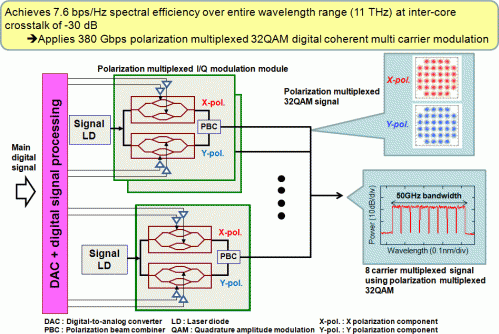
NTT and three partners- Nippon Telegraph and Telephone Corporation, Fujikura Ltd., Hokkaido University, and Technical University of Denmark—demonstrated ultra-large capacity transmission of 1 petabit (1000 terabit) per second over a 52.4 km length of 12-core (light paths) optical fiber.
The present achievement indicates that transmission of one petabit per second (Pbps), capacity equivalent to sending 5,000 HDTV videos of two hours in a single second is possible over 50 km, which is approximately the distance between medium-haul telecom offices. This sets a new world record throughput over a single strand of optical fiber. This achievement was reported as a postdeadline paper on September 20, 2012 at the European Conference and Exhibition on Optical Communications (ECOC 2012), the largest conference on optical communication in Europe, that was held in Amsterdam, the Netherlands, from September 16-20, 2012.
Recent figures by the Ministry of Internal Affairs and Communications indicate that broadband services, driven by FTTH and smartphones, will continue to expand rapidly, and traffic will continue to grow apace at a rate of 1.2 times per year (a 10-fold increase in 10 years) for the foreseeable future. Efforts to increase the capacity of optical networks to accommodate surging traffic demand have largely focused on driving down infrastructure costs by using more efficient optical communications equipment to support more widespread deployment of broadband services without changing the structure of optical fiber itself. The optical fiber used in today's long-haul high-capacity optical networks has a single core-a single optical signal path-with a throughput of 1 terabit per second in the present commercial systems. Yet, due to the traffic increase, we face a serious challenge in meeting this traffic demand in the years ahead.
Addressing these concerns, Professor Toshio Morioka of the Technical University of Denmark (DTU), conceived a novel scheme for implementing long-haul high-capacity optical networks that could support increased traffic loads into the future. Professor Morioka's proposal of developing spatial multiplexing optical communication technology including multicore optical fiber (MCF) and other novel optical fiber designs has been driving this sector ever since. Indeed, Professor Morioka's proposed approach has emerged as a dominant worldwide trend in the quest for greater capacity optical communication systems. In order to assess the viability of this approach that was proposed in Japan, two companies and two universities-NTT, Fujikura, Hokkaido University, and DTU-combined their expertise to develop multicore optical fiber designs, fabrication techniques, and spectrally-efficient transmission technologies to derive maximum performance from spatial multiplexing optical communication transmission to reach the target throughput.
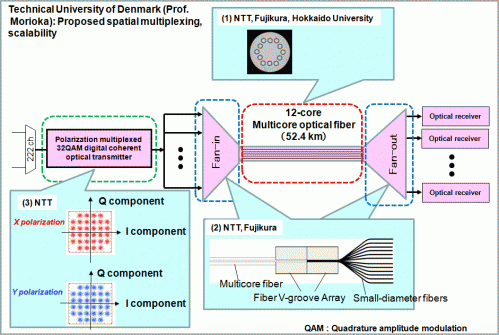
With the goal of significantly improving the capacity of optical communication systems, we developed a new 12-core MCF structure with the cores arranged in a nearly concentric pattern, a novel fan-in fan-out device, and applied a digital coherent optical transmission scheme for transmitting dense wavelength division multiplexed signals in each core. The new core arrangement markedly reduced signal leakage (crosstalk) between adjacent cores, which had been a problem with conventional MCF designs. Moreover, by applying polarization multiplexed 32QAM (quadrature amplitude modulation) digital coherent technology that exploits the wave properties of light to transmit multiple signals, we successfully boosted transmission efficiency per core by more than 4 times that of the MCF transmission previously reported. This yields a transmission capacity of 84.5 terabit per second for each core (= 380 Gbps capacity per wavelength X 222 wavelength channels), for a total capacity of 1.01 petabit (= 12 X 84.5 terabit) per second for the 12-core optical MCF through 52.4 km of fiber. Because the Q-value representing communication quality is extremely uniform across all cores, this means there is little variation in quality from one core to the next, and that error-free communication is feasible.
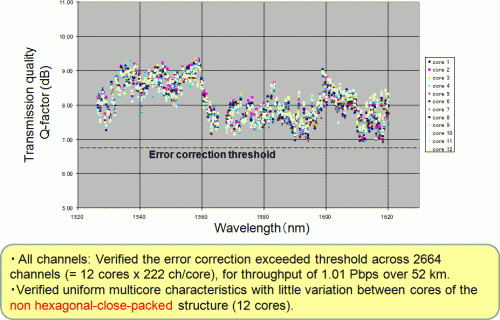
This breakthrough enabled us to achieve 1 petabit throughput capacity for the first time ever and have surpassed the previous record over conventional optical fiber by more than 10 times the throughput capacity. In the new target domain made possible by spatial multiplexing optical communication technology, the present achievement has also surpassed the previous record of 305 Tbps (tera = 1 trillion), to establish a new world record of 1 Pbps.
With MCFs, it is important to minimize leakage of light (crosstalk) between adjacent cores while maintaining the same or better transmission loss characteristics than that of conventional optical fibers. This represents a major challenge, since previous MCF's structure with over 7 cores tends to increase crosstalk, which reduces transmission capacity in each core.
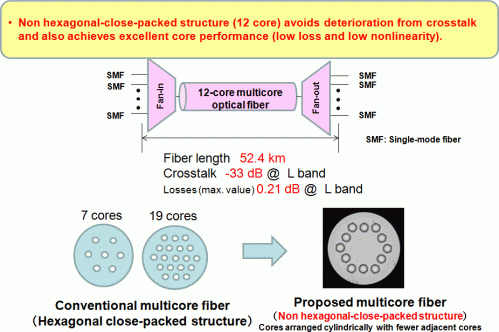
For this work, Fujikura and Hokkaido University collaborated in the design of a new structure MCF (non hexagonal-close-packed structure) that arranges the 12 cores in a near cylindrical configuration. By implementing the fiber with only 2 adjacent cores-one on the right and one on the left-crosstalk is markedly reduced compared to the typical structure MCF, and this novel design also realized low-loss characteristics. NTT evaluated the characteristics of the new structure MCF and found that the optical signal losses of each core were roughly the same as those of conventional optical fibers, inter-core crosstalk was reduced to well within design parameters, and optical characteristics were uniform among cores.
In order to use conventional transmitters/receivers, we must establish a viable device for efficiently coupling to each of the 12 cores of the MCF via conventional single mode fibers (fan-in and fan-out: stable coupling between 12 conventional fibers and a 12-core MCF). For this project, we developed a device that precisely aligns 12 separate single mode fibers that have been thinned to less than a 1/3 their regular diameter to the 12-core MCF that satisfies our fan-in fan-out requirements: low crosstalk and low insertion loss.
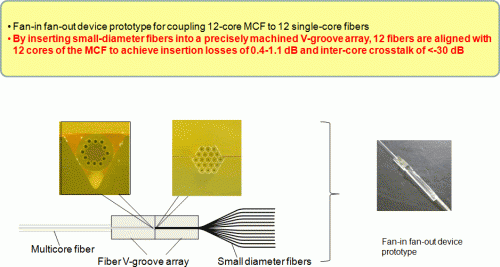
Optical communication generally uses a scheme in which light signals are represented in either one of two intense states: either ON or OFF. For this project we developed an alternative approach that provides even smartphones with enough digital signal processing capability to apply and extend optical communications by creating multi-signal states using the properties of lightwaves-phase and polarization. Applying the 1's and 0's of digital signals to this multi-signal state scheme in combination with polarization multiplexed 32QAM digital coherent technology, we were able to achieve stable transmission in optical MCF in the presence of some degree of crosstalk. In addition, transmission efficiency per wavelength shows close to a ten-fold improvement over conventional ON/OFF modulation.
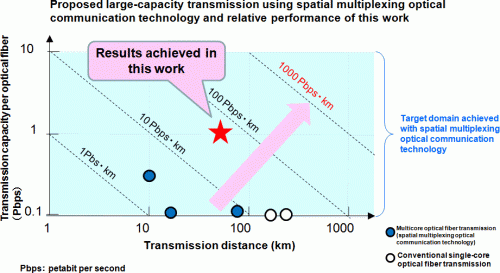
The researchers have demonstrated key technologies for implementing a breakthrough optical communication system that dramatically boosts the transmission performance of prevailing commercial technology by over 1,000 times. With further cooperation and development of these technologies that exploit the freedom of optical fiber spatial structures, optical amplification, and spectrally-efficient transmission technologies, this will open the way to even longer distance transmission and very large capacity optical networks that support the continued rollout of broadband services in the years ahead.
More information:
www.soumu.go.jp/main_content/000149220.pdf
T. Morioka, New generation optical infrastructure technologies: "EXAT initiative" towards 2020 and beyond, 14th Optoelectronics and Communications Conference, OECC 2009, FT4 (2009).
A. Sano et al, 102.3-Tb/s (224 x 548-Gb/s) C- and Extended L-band. All-Raman Transmission over 240 km Using PDM-64QAM. Single Carrier FDM with Digital Pilot Tone, OFC.NFOEC2012, PDP5C.3 (2012).
Sakaguchi, et al, 19-core fiber transmission of 19 x 100 x 172Gb/s SDM-WDM-PDM-QPSK signals at 305 Tb/s, OFC.NFOEC2012, PDP5C.1 (2012).
Provided by NTT


















